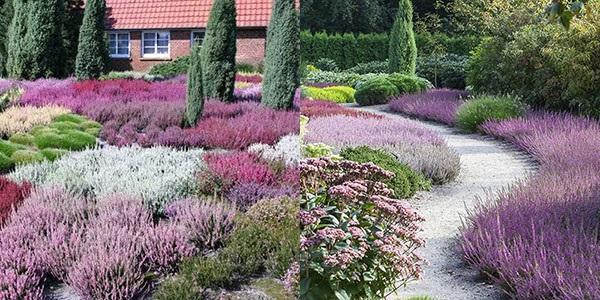Fascinating varieties of heather
 Every gardener is a kind of artist, only instead of a brush he holds a hoe and a sapling in his hand. Therefore, various varieties will help create a masterpiece from your garden. heather, which are diverse in their colors and shapes. It is these crops that can grow in bare, windy areas.
Every gardener is a kind of artist, only instead of a brush he holds a hoe and a sapling in his hand. Therefore, various varieties will help create a masterpiece from your garden. heather, which are diverse in their colors and shapes. It is these crops that can grow in bare, windy areas.
In nature, shrubs are most often found on mountain slopes, swamps, wastelands and peat bogs. For the northern regions, they are the most suitable.
Heather varieties in their splendor
The foliage of the shrub has many colors. In addition to all shades of green, there are also silver, yellow, orange and bronze. Each branch ends with clusters of goblet-shaped inflorescences. They are:
- snow-white;
- red;
- pink;
- raspberry;
- burgundy.
This luxurious palette adorns the flower bed before the cold weather. Dried flowers retain their color and snowfall in this form. Gardeners use some varieties of heather as fall / winter annuals. At the end of August, they transfer the plant to pot or in a planter / balcony box.
To date, there are 500 known varieties that differ:
- Flowering form. There are terry, simple and unopened buds.
- Foliage colors. They are divided into three groups: yellow (a combination of red and orange), green, and blue with a gray tint.
- Coloring flowers. Red, purple and pink varieties are popular. Still, whites are considered rare.
- The height of the bush. Low-growing ones resemble moss covers, but they often undermine. Tall and medium are distinguished by the density of the bush.
If a culture grows in the harsh climate of Siberia, then it can rightfully be called winter-hardy. Therefore, she does not need shelter, with the exception of a few thermophilic (terry) varieties.
Secret growing technology
The entire internet is flooded with complaints that the heather does not survive the winter. How can this be if it grows wildly in the neighborhood in the forest? The whole secret lies in several nuances:
- Acidic soil. The heather root system cannot thrive without the simplest fungal bacteria. The well-being of the shrub depends on their close symbiosis. At the same time, fungal organisms need moisture, organic matter and an acidic environment.
- Landing time. The best option is early spring.
- Sunny area. Good lighting is the key to thriving bloom. As an exception, they choose a partial shade created by thuja or pine.
- Moderate feeding. Too many minerals and fungicides lead to suppression of mycorrhizal fungal roots.
- A haircut. Dried needles should be cut in the spring, and not thrown away the entire bush at the end of March.
The peak of flowering falls in the fall. It is then that the seedlings appear on sale. Therefore, the sooner they are planted, the better they will take root.
The bush should be trimmed as close to the top as possible, because the dormant buds are concentrated in these places. Perhaps this is one of the main requirements for all varieties of heather, because the plant blooms on the shoots of the last year. This is how you can easily take care of them.